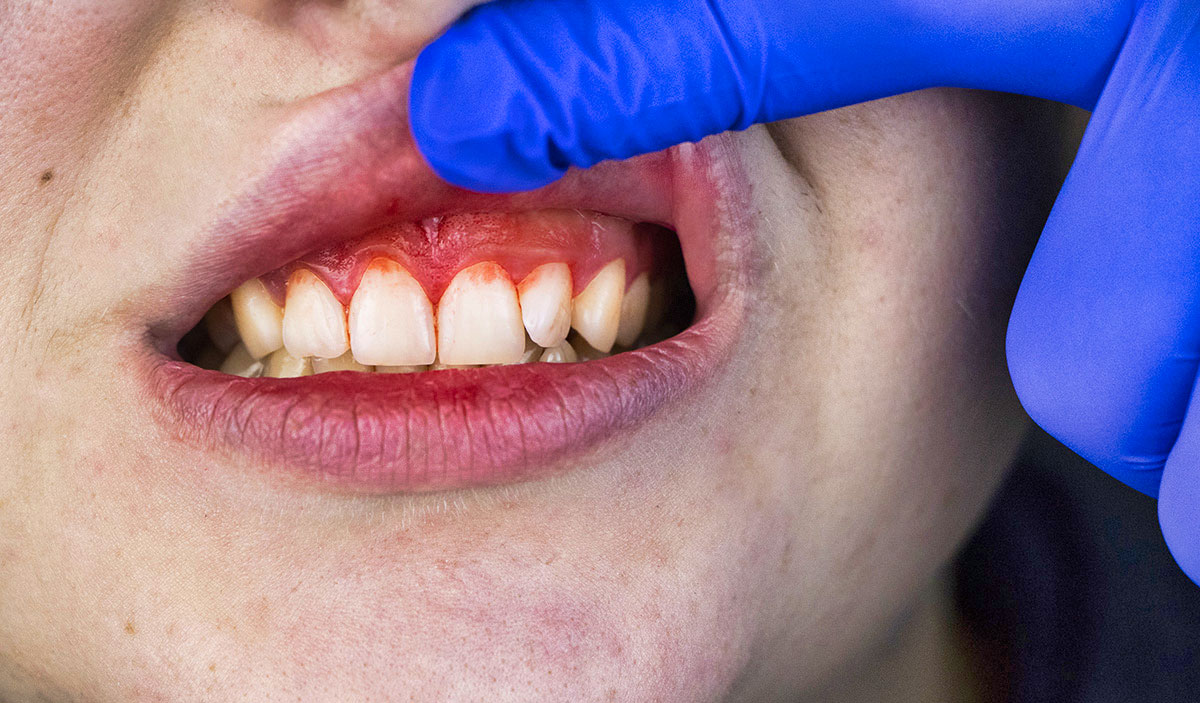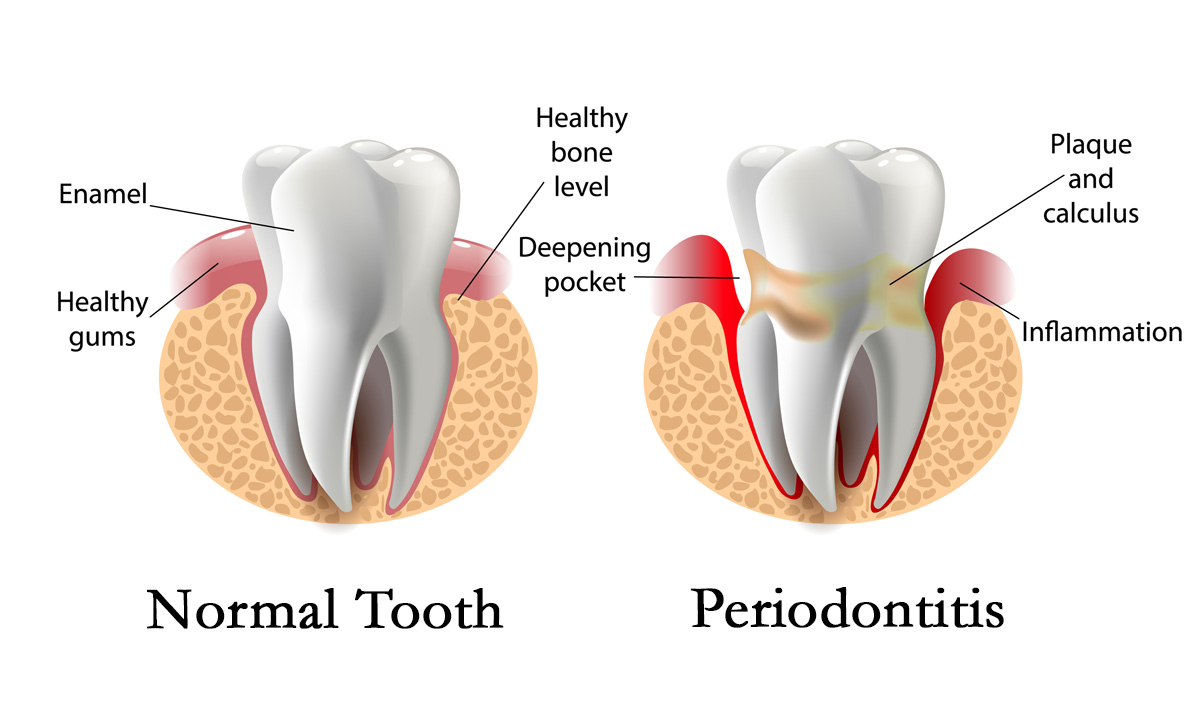Gum Disease (Gingivitis & Periodontitis): Causes, Stages, Symptoms and Treatment
What is Gum Disease
Gum disease, also called Periodontal Disease, is an infection of the tissues that hold your teeth in place. It is a prevalent and largely preventable oral health condition that is caused by poor oral hygiene. There are two main types of gum disease- gingivitis and periodontitis.
Gingivitis is the most common and less serious form of gum disease and is caused by a bacterial infection resulting in an inflammation of the gums. Periodontitis is a more serious condition and occurs when the infection spreads to the bone that holds your teeth in place (the periodontal ligament), and if left untreated, destroys bone and soft tissue around the teeth leading to potential tooth loss if not properly treated.
Gum Disease is very common in Australia, with 3 in every 10 adults having moderate to severe gum disease. In fact, gum disease is one of the leading causes of tooth loss in adults. It is mostly seen in adults, and it is more common in men than women, those living below the poverty level, and current smokers. Periodontal disease and tooth decay are two of the biggest threats to dental health, and they often occur together.
Gum Disease Causes
The common cause of gum disease is plaque build-up and bacteria. Gum infections starts out as gingivitis and is caused by bacterial growth in the mouth. When microorganisms remain on the teeth for an extended period of time, they build a film known as plaque.
Plaque is a sticky film of bacteria that builds up on teeth to become tartar if not removed, which if not removed will then harden and form calculus. The bacteria found in plaque (biofilm) and calculus will irritate the gums and cause inflammation and infection leading to periodontitis if not addressed.
As the inflammation progresses, it destroys the tissues that support the teeth (periodontal ligament and alveolar bone). Tartar accumulation may expand below the gum line, making it more difficult to clean the teeth.
Many of the bacteria in plaque are completely harmless, but there are some that have been shown to be the main cause of gum disease. These bacteria feed on the sugars and starches found in food and if plaque isn’t removed regularly, it can harden into tartar. Tartar can only be removed with special tools by your dentist or dental hygienist.
Risk factors
There can be many risk factors to gum disease and people are more likely to develop gum disease through any of these factors:
• Smoking and tobacco use. Smoking or chewing tobacco not only lead to bad breath and stained, yellowed teeth, but also cause gum disease and make mouth cancer more likely
• Diabetes (blood sugar imbalance) or other diseases
• Poor dietary habits. Unhealthy diet, too little sleep, and too much stress can make you more vulnerable to infection anywhere in the body, including your gums
• Genetics.
• If your parents have gum disease, you may be more likely to get it too. The American Academy of Periodontology says that up to 30% of Americans may be more likely to get gum disease because of their genes.
• Certain medications, such as phenytoin , cyclosporine , calcium channel blockers, and oral contraceptives. The anticonvulsant Dilantin and the angina medications Adalat and Procardia, might result in aberrant gum tissue development. (these medications can cause gingivitis or make it worse because they can lead to an overgrowth of gum tissue and make plaque hard to remove)
• Severe deficiencies of vitamin C (this is rare in the United States)
• Hormonal changes, including during pregnancy and menopause. Increases in hormones during puberty can make gums more sensitive to irritation
• Leukemia
• Exposure to bismuth, which can be found in some makeup
Gum Infection Symptoms
Symptoms of gum infection and disease that are warning signs can include:
• Bleeding or Swollen gums (healthy gums rarely bleed)
• Bleeding gums when you brush or floss or when eating (especially hard foods)
• Any change in the way your teeth fit together when you bite
• Longer-looking teeth and receding gums
• Any change in the fit of partial dentures
• Tender-to-the-touch gums
• Spaces developing between teeth and gums, causing pockets to form
• A buildup of pus between teeth and gums
• Teeth becoming misaligned
• Mouth sores
• Buildup of hard brown deposits along the gum line
• Chronic bad breath (halitosis)
• Persistent mouth pain
• Loose teeth
Stages of Periodontal Disease: Gingivitis vs Periodontitis: What is the difference?
Periodontal diseases are characterised by the extent of damage to bone and gum tissues surrounding teeth. Treatment for gum disease varies according to the stage and kind of Periodontitis, and may range from a basic professional dental cleaning to comprehensive periodontal surgery, soft and hard tissue grafting, or dental implants to replace teeth that have been lost or cannot be salvaged.
The depth of periodontal pockets is an important determinant of the stage of gum disease and the hazards to the patient’s oral health.
There are four distinct stages of periodontitis:
• gingivitis
• slight periodontal disease
• moderate periodontal disease
• advanced periodontal disease
Gingivitis – Early Stage Gum Disease
The earliest stage of Gum Disease (Periodontitis) is called Gingivitis and is a mild form of gum disease that is characterized by gum inflammation (potentially an infection). Gingivitis can be identified by its painless symptoms, which include bad breath and swelling or redness of the gums and bleeding during brushing or flossing.
The main characteristic of gingivitis is that it is the only stage that is reversible with proper dental hygiene. At this stage when the gums become inflamed they begin to lose their attachment to the tooth. This leaves the previously covered enamel exposed and at risk for decay. It often persists for years before it becomes destructive, so it is important to have the condition treated if you think you might have it. Brushing and flossing help in the removal of plaque.
Gingivitis, as the mildest form of gum disease can be difficult to distinguish from early periodontitis. Your dentist can diagnose it by probing your gums with a small ruler during a dental exam.
This probing is used to detect inflammation and will help to determine the stage of gum disease. If the issue is not addressed at this stage, the bone supporting the teeth can be lost, causing the teeth to become loose.
Early Periodontitis
Stage two is known as early periodontitis. This stage is not reversible, but it can be managed with the help of a dentist. Once a patient reaches this stage, the infection has spread to the bone and begins its bone-destroying process. Early periodontitis is characterised by a decrease of tooth support, which, if not addressed, may progress to bone loss.
If you are experiencing any of the following symptoms, it is important to visit a dentist and get diagnosed for early periodontitis: increased swelling or redness of the gums, bleeding during flossing or brushing, and probing depths ranging from four to five millimetres. Therapy for early periodontitis usually includes tooth scaling and root planing accompanied by good oral hygiene.
If you are diagnosed with early periodontitis, there is usually no need for additional work. The dentist will clean your teeth and instruct you on how to brush and floss correctly. You may also be given a prescription for mouthwash that contains chlorhexidine. This mouthwash helps kill bacteria and reduce inflammation.
Moderate Periodontitis
Moderate periodontitis is the most critical phase of gum disease. If not treated, it can progress to irreversible bone and tooth loss. The symptoms are very similar to the earlier stages, but the probing depths will be greater at six to seven millimeters. The connective tissues and alveolar bone become seriously infected, leading to teeth shifting. Bacterial toxins and the body’s enzymes break down the bone that holds teeth in place, leading to tooth mobility.
Treatment at this stage will likely consist of a deep cleaning method known as scaling and root planing. This procedure removes tartar and hardened plaque from deep within your gums. If the disease has progressed to this stage, there is no reversing it, but surgical proceduess can stop its further progress and can help with some of the symptoms and pain.
Advanced Periodontitis
Advanced periodontitis is the final stage of periodontitis. It is much more severe than the earlier stages and requires surgery or laser therapy to combat it. This final stage is characterized by severe infection, loosening teeth which could possibly fall out.
If advanced periodontitis is not addressed, it can cause significant health problems. Teeth may start to space or gap, gum recession may occur, and patients may eventually need dentures. In the most serious cases, stage 4 can even lead to heart disease and stroke.
• Advanced Periodontitis includes:
• Constant bad breath and bad taste
• Spontaneous gums bleeding
• Sensitive teeth due to exposed roots
• Pus drainage in the mouth due to periodontal
• abscesses
• Pocket depth over 7mm
If gum disease has reached the advanced stages, extensive surgery is necessary to save the affected teeth. This may include bone grafting, soft tissue grafting and/or crown lengthening. Depending on the severity of the infection, tooth extraction may also be necessary.
The relationship between systemic diseases and periodontal diseases is still being studied.
While no definite relationship has been shown, several studies suggest that severe gum disease may be connected with a number of other health conditions, including diabetes and stroke according to the American dental association. Additionally, persistent chronic inflammation may place a burden on the immune system.
Gum Disease Treatment
How is Gum disease treated? Gum disease is the most common type of dental disease. Almost 90% of the population will need this condition addressed at some point in their life for gum disease. The goal is to control the infection and prevent it from spreading.
There are various approaches that are effective in treating gum disease. These options vary depending on the stage and severity of gum disease, one or more of these curative approaches may be recommended which may include antibiotics, scaling and deep cleaning, and surgery.
It’s important to have the condition addressed early if you think you might have gum disease, as it can lead to more serious health problems if not dealt with.
Treatment Goals
The main goals of periodontal therapy, are to reduce inflammation in the gums and stop the progression of the disease. In some cases, periodontal therapy may also be used to identify and address underlying causes or contributing systemic illnesses. The goal of replacing lost teeth is to prevent further damage and recurrence in the future.
There are different goals in order to prevent gum disease, depending on its severity. If it is caught in the early stages, the goal may be to simply stop the progression of the disease. In more advanced cases, the goal is to restore damaged tissues. If too much damage has been done and teeth must be extracted, the goal shifts to preventing further damage and helping patients regain their lost quality of life.
The main therapeutic goals of periodontal therapy are to:
• Reduce inflammation
• Eliminate the bacterial infection that causes gum disease, and its etiology
• Identify and address any underlying causes or contributing systemic illnesses
• Prevent the recurrence of periodontitis / eliminate periodontal pockets to allow the patient to easily maintain good oral health
• Restore damage caused to soft or hard tissues (gums, periodontal ligaments and bone)
If it is too late to be saved, replacement teeth may need to be implanted.
The Therapeutic Process
The therapeutic plans for gum disease vary depending on a person’s different risk factors, the most common of which are smoking, uncontrolled diabetes, and lack of proper dental hygiene habits. Being treated by your dentist may involve a combination of professional cleaning, antibiotics, and/or surgery.
The first step is to identify and eliminate the factors that make the person more susceptible to gum disease. This may include improving dental hygiene, quitting smoking, and treating any underlying medical conditions.
In order to eliminate gum disease in its earliest stages (gingivitis), it is important to brush and floss your teeth after every meal with the help of a dentist’s prescription mouth rinse.
In cases of periodontal disease, deep scaling may be used to clean the teeth and remove plaque and tartar below the gum line. This can help improve the health of the gums and reduce pocket depth.
On the other hand, flap surgery is a common surgical procedure that can be performed to treat gum disease. This surgery is often combined with a pocket-reduction surgery so that it will be easier for the patient to clean their teeth. The procedure consists of numbing the gums, then lifting them back to expose the teeth. The dentist will then clean and sometimes reshape the bone around the teeth.
Your dentist may recommend a soft-tissue graft. This surgery is used to cover up root surfaces that are exposed by gums that are receding. The grafts are usually made of tissue from the roof of your mouth or from a synthetic material.
Another alternative, laser therapy, can be an effective way to improve gum health. The soft-tissue laser is specifically used to treat gum pockets, which are a common symptom of gum disease.
The pocket is treated with the laser deep inside the pocket, which helps eliminate harmful bacteria and stimulate healing. Alternatively, gum pockets and unhealthy tissue are removed are removed from the pocket after treatment with a laser that uses light energy to vaporize tissue and kill bacteria. This leaves healthy gum tissue behind, promoting long-term gum health.
By using this specialized laser, the doctor can remove the diseased tissue and help promote healthy growth in the gums.
In conclusion, gum disease is a common issue in society which can largely be prevented by developing good flossing habits, brushing your teeth twice a day with fluoride toothpaste, having a balanced diet (minimizing sugar intake) and by scheduling regular appointments with your dentist who can remove tartar not addressed by your personal dental care.
canley heights Office
Shop 2, 192 Canley Vale Road Canley Heights, NSW 2166
bankstown Office
Shop B108, Little Saigon Plaza
462 Chapel Road
Bankstown NSW 2200
Hours
M-F: 9am–5pm
S-S: 9am–5pm
info@alwayssmiles.com.au




